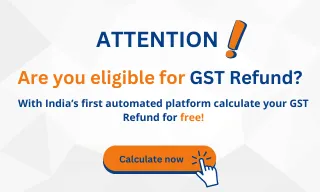GST Refund Challenges for Exporters
Published on: Mon May 16 2022
It’s a harsh reality, especially in this fully automated GST refund era, wherein document sharing and verification between the GST Authorities and taxpayers should be a seamless process, yet it is hard for the exporters to get their GST refunds with ease and convenience.
Some of the major reasons why the GST refund of the exporters is either getting delayed or rejected are enumerated below:
Major GST Refund challenges faced by the exporters
Restricted GST Input Tax Credit refund to GSTR 2A

As per the GST framework [Circular 135], Government mandates that input tax credit (ITC) refunds should not be granted on invoices that are not reflected in GSTR-2A – a form that reflects outward supply invoices uploaded by suppliers.
It appeared that though the exporter is eligible to claim the GST ITC refund against the whole inputs or input services used by him for making the export supplies yet he is eligible to claim the refund for only those invoices against which corresponding details are reflected on the government portal in GSTR 2A. Rest eligible ITC refund may be rejected/ denied by the GST Authorities as the same is not appearing in GSTR 2A.
After the post introduction of the said restriction, many exporters are unable to take ITC refunds running into big numbers as there are several cases where suppliers/ vendors failed to upload the relevant GST return [GSTR-1 “Statement of outward supplies”] on the GST portal within the stipulated time.
Resultantly, exporters face a huge working capital crunch as they are unable to claim the ITC and ultimately face difficulty in getting their GST refunds.
Time Limit to file GST refunds

Generally, the time limit to file the GST refunds is two years. Now, the most important question that needs to be addressed here is “from when these two years should be counted in case of exports?”
In the case of service export, it is two years from the date of receipt of remittance.
In case of any deficiency pointed out by the GST Authorities in the refund application, an exporter is required to file the fresh refund application again within the time limit of two years.
Now what happens is that suppose an exporter files the GST refund application in the last month of the two years period and the department points out any deficiency, an exporter is liable to file a fresh refund application within the same time frame of 2 years. Unfortunately, where the exporter fails to do so and the time limit of two years expires, the refund application gets time-barred legally and the whole refund applied by the exporter gets spoiled.
Partial payment received on export invoices

While filing a GST refund application, an exporter is required to submit Statement-3 [a statement containing the details of invoices against which the remittances have been received]. One of the major problems faced by the exporters with Statement-3 is that it freezes the invoices entered irrespective of the fact whether full or partial payment is received. Once the invoice number is entered in any particular claim period, the GST portal freezes that particular invoice, and the refund cannot be claimed against the same invoice in a future period.
In the case of partial payments, while filing a refund claim in respect of the particular invoice next month, it doesn’t capture the details of the invoice as it has already been entered in the previous month. It leads to a mismatch with export turnover and hence creates confusion among the exporters.
No GST refund on capital goods leading to piling of ITC

Refund of the Input Tax credit on capital goods is not available to the exporters. The government intends that the refund facility can be easily misused in the case of capital goods where the exporters can claim the whole refund of ITC on Capital Goods in a single month and in the next months it starts using those Capital goods in domestic supplies. Ultimately the sufferer is 100% exporter, whose ITC on capital goods gets piled up due to no refund.
Farce provisional GST refunds

As per GST law [Rule 91], 90% of the claimed refund by the exporter must be sanctioned provisionally within 7 days of the acknowledgment issued against the GST refund application. However, this is not happening in reality. GST Authorities put the provisional refund of the exporters on hold due to various reasons and as a result, the exporters face a lot of liquidity cost burden and delay in early cash that ultimately has an impact on the exports.
Uploading incomplete and inappropriate documentation

It is required that all legible supporting documents as required under law to be filed along with the refund application in case of exports should be uploaded on the government portal in the appropriate format such that the chances to get the deficiency memos and refund rejections get lessened.
In cases, where the exporter fails to furnish the proper documentation in the required format, the GST department may issue a deficiency memo and as a result, this can be challenging for the exporters to get their GST refund sanctioned.
Suppose while submission of GST refund application, Annexure – B, “Statement of input invoices” is one of the documents that need to be prepared in the format specified by the Government and submitted along with. Any missing content in the Annexure like non-provision of HSN summary wise details etc. may arise a situation for the exporter wherein a deficiency memo will be issued by the department and the GST refund of the exporter may get rejected.
Also, check out the Refund of IGST Paid on Ocean Freight.
FAQs
- What is GST refund and why is it important for exporters?
GST refund refers to the reimbursement of Goods and Services Tax (GST) paid by exporters on inputs used in the production and export of goods or services. It is important for exporters as it helps to prevent the accumulation of tax on exported goods, ensuring competitiveness in the international market.
- Are there any specific documentation requirements for GST refund applications?
Yes, there are specific documentation requirements which may vary based on the jurisdiction. Generally, exporters need to submit invoices, shipping bills, export declarations, bank statements, purchase orders, and other relevant documents to support their refund claims.
- What are the common challenges faced by exporters when claiming GST refunds?
Common challenges include complex documentation requirements, delays in processing and disbursing refunds, issues with verification and audits, lack of clarity in refund rules, and the need for expertise in navigating the refund process.
Are you Looking for GST Refund Service? Mygstrefund.com offers GST refunds on business, exports, and many more if your GST application is rejected. Get in touch with us today.
Related Posts






